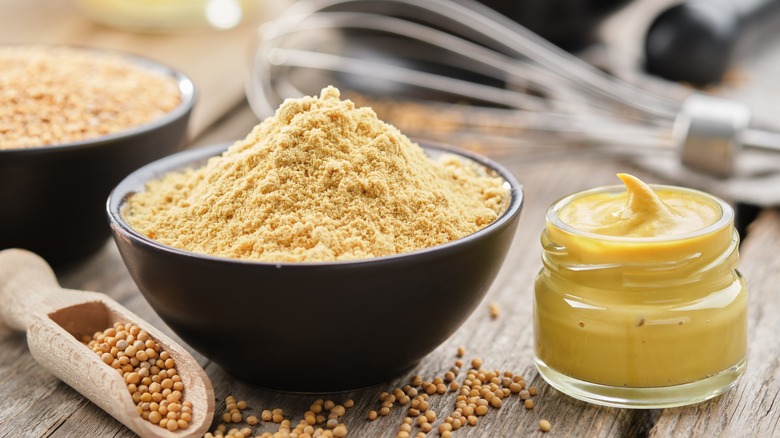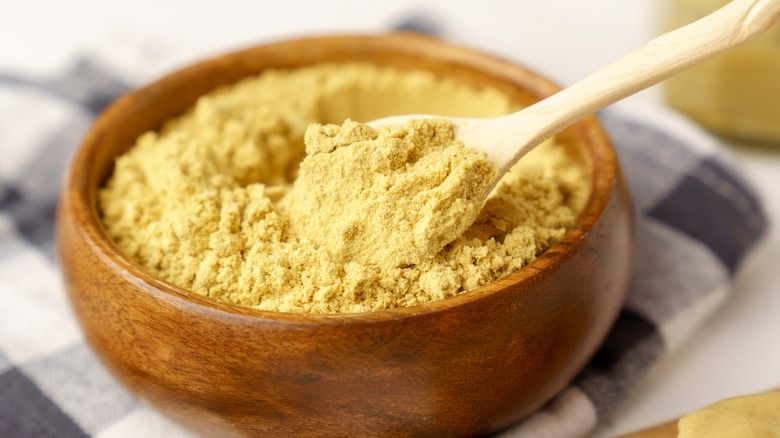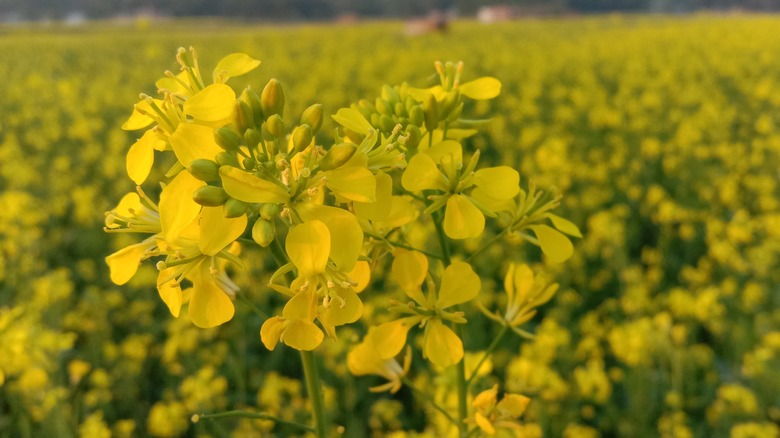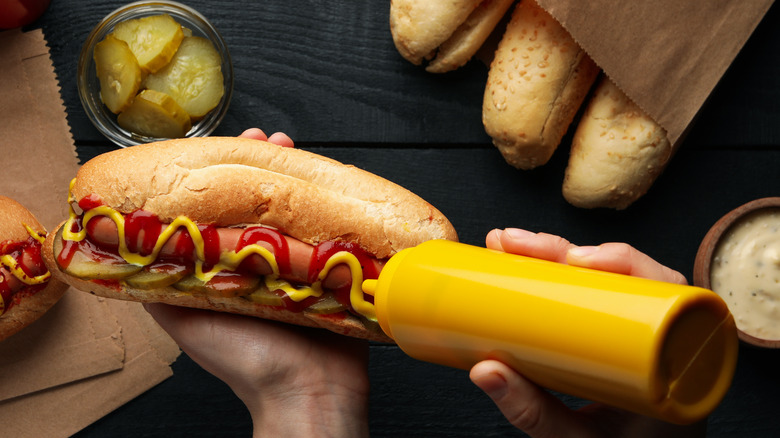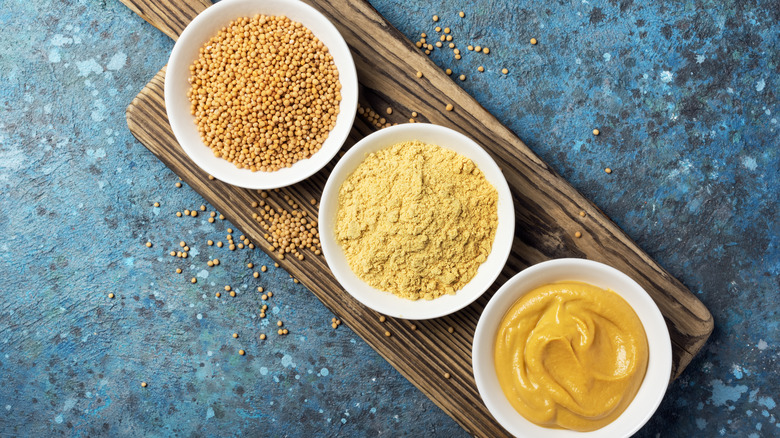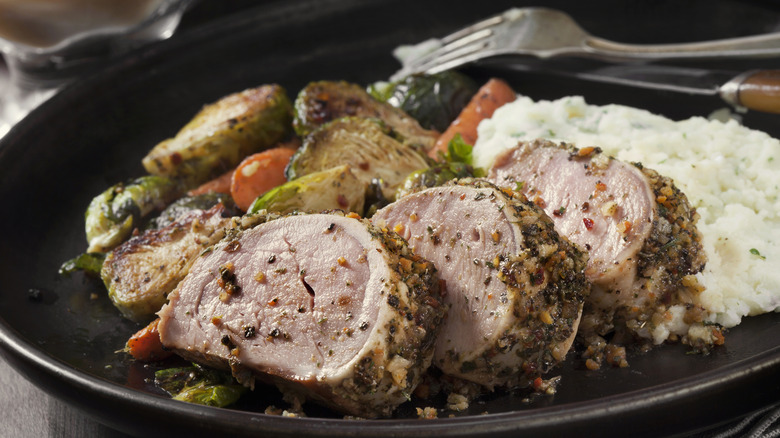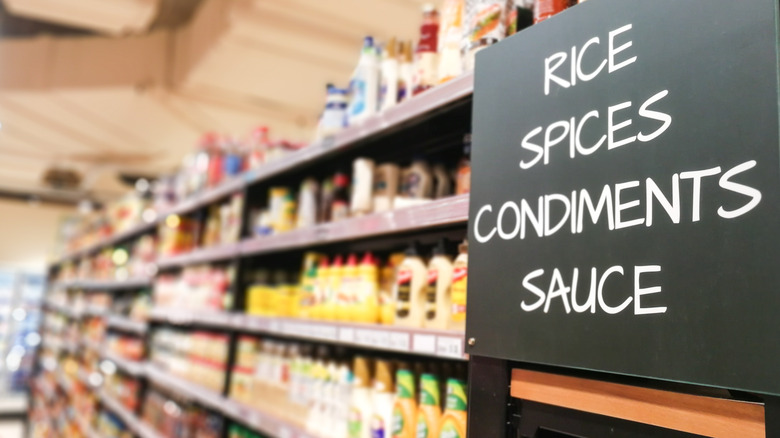What Is Mustard Powder And How Do You Cook With It?
There are a few condiments that seem so ubiquitous, it almost feels like some form of them can be found in every household. For instance, there's hardly a refrigerator without cold condiments like mayonnaise, ketchup — and mustard. Mustard is such a basic yet unique product that it can feel futile trying to describe its zingy, zippy taste. (In truth, you can thank the compound allyl isothiocyanate for its signature sinus-clearing strength). But the condiment version you're no doubt familiar with isn't the only form of mustard. It turns out there's a spice that also comes from the yellow mustard (Brassica alba) plant, and it's the same familiar yellow color as the bottle of French's or Heinz you've got in your cabinet. It's not named anything tricky or anything, either: it's just mustard powder (or ground mustard).
As for how to use it ... well, the sky is really the limit there. It's a wildly versatile spice that tends to play well with others, while naturally boosting savory foods in particular. The more you know about this fundamental spice, the better you'll be able to implement it in your own cooking.
Where does mustard powder come from?
The Brassica alba plant has spread around the world, but it probably originated in the Mediterranean region. Yellow mustard is actually a crop weed, and is sometimes considered an invasive species. This isn't a complicated product in description — it's literally mustard, like what's in the condiment, but in powder form. It does what it says on the tin.
Mustard powder as we generally know it is also distinct from brown mustard, which is native to the Himalayas. The origins of each do a lot to explain the cuisines in which they heavily feature; brown mustard — which has a much stronger, more pungent flavor — tends to appear a lot more frequently in Indian, Chinese, and Southeast Asian cuisines, while yellow mustard is more common in European foods. Brown mustard seeds themselves (not ground up) are often eaten and used as a spice in Asian dishes, particularly in South Asia. Yellow mustard is also sold in whole grain form, but smooth spreads are especially popular.
How is mustard powder made?
Simply put, mustard powder is just pulverized yellow mustard seeds that are ground into a fine powder rather than getting further refined into a condiment. The seeds are removed from the mustard plant, then husked, then ground up, and the end result is what winds up on store shelves.
It's worth noting that ground mustard is actually a step on the road to yellow mustard as you're probably familiar with it. While mustard powder gets shipped and sold once it's ground, in order to make the condiment, the powder is combined with water, vinegar, maybe lemon juice or wine (depending on the brand), and spices like salt, paprika, turmeric, and garlic powder. The liquid is the important thing here: no matter which liquid is involved, it causes an enzymatic reaction that releases sulfurous compounds within the powder, leading to a more pungent taste. A lot of what you associate with the taste of "mustard" as you probably know it is the result of this reaction.
Mustard powder versus condiment mustard
Both mustard and mustard powder have their ideal uses. For instance, you wouldn't want to put mustard powder on a hot dog unless you were trying to have a real bad time. But mustard as a condiment can affect a food's texture in cooking thanks to its liquid content — and in processed mustard, you're going to get some flavors you might not have been bargaining on, like sugar and vinegar.
It comes back to that pungent flavor. Ground mustard doesn't really have that, because the enzymatic reaction that creates myrosinase and glucosinolates like sinigrin, myrosin, and sinalbin hasn't occurred. What you're left with is just profound bitterness and earthiness, with none of that vinegar tang you associate with mustard itself. You don't want to sprinkle this on top of a finished food, because that's a really bad idea. But yellow mustard and mustard powder do share mustard's curious quality of blending well with other flavors; there's a reason mustard powder works so well in spice blends, while yellow mustard pairs so well with condiments like ketchup, mayonnaise, or BBQ sauce.
What does mustard powder taste like?
The main difference in taste between raw ground mustard and yellow mustard is that the condiment is flavored with extra ingredients like paprika and sugar, whereas mustard powder is the seasoning in all its naturally earthy, bitter, and spicy glory. Like any other spice, you're not going to want to eat it straight, but mustard powder is probably more of an unpleasant experience to eat a spoonful of than a lot of other spices. It's almost indescribably bitter and pungent.
But that's fine, because the point of mustard powder isn't how it tastes on its own — again, you're not going to sprinkle it on top of a finished dish — but rather in how it pairs with other spices. Mustard powder is great in blends because it lends those earthy notes without overwhelming other ingredients; the counterpoints that spices like coriander, cumin, or saffron bring marry really well with mustard powder. It's the definition of a team player in the kitchen.
How to cook with mustard powder
The main way you're going to be using mustard powder is in spice blends or spice rubs. It has an ability to cut through creaminess and fattiness without becoming overwhelming, and generally doesn't dilute a dish's richness so much as balance and augment it. It's not typically found in desserts, but it has a wide range of other applications in anything savory. Professional and celebrity chefs, it's worth noting, absolutely love the stuff: Ree Drummond swears by it for mac and cheese, and Alex Guarnaschelli says it's great for deviled eggs (and they're both right). It's also great in things like salad dressings for the same reasons.
One of the best ways to use mustard powder, though, is probably in conjunction with meat. Mustard powder has a fantastic tendency to bring out the flavors in various meats (beef, chicken, turkey) as a spice rub, but nowhere is it more potent than in pork — hence the reason for its popularity in German cuisine, which tends to make heavy use of pig products. You've probably seen condiment mustard used as a rub for BBQ items like pork butt; mustard powder is similarly beneficial.
Where to buy mustard powder
Fortunately, this is the easy part: you should be able to get mustard powder at any grocery store. It occupies that spice sweet spot where it's common enough that it's easy to find, but not so well-known that it gets overused in cooking. It's a true chef's spice, so finding it shouldn't be an issue. You can also order it in bulk online if you'd prefer. It's a dried spice, so it both travels well and keeps for a long time; it generally stays at best quality for two to three years, and its unlikely that it will hurt you if you eat it even after that (it just won't taste as good).
However you get your mustard powder, you should really try cooking with it. The unexpectedly zesty, savory flavor it adds to ingredients really punches up a number of dishes, and both you and your guests will be thrilled with the results.
